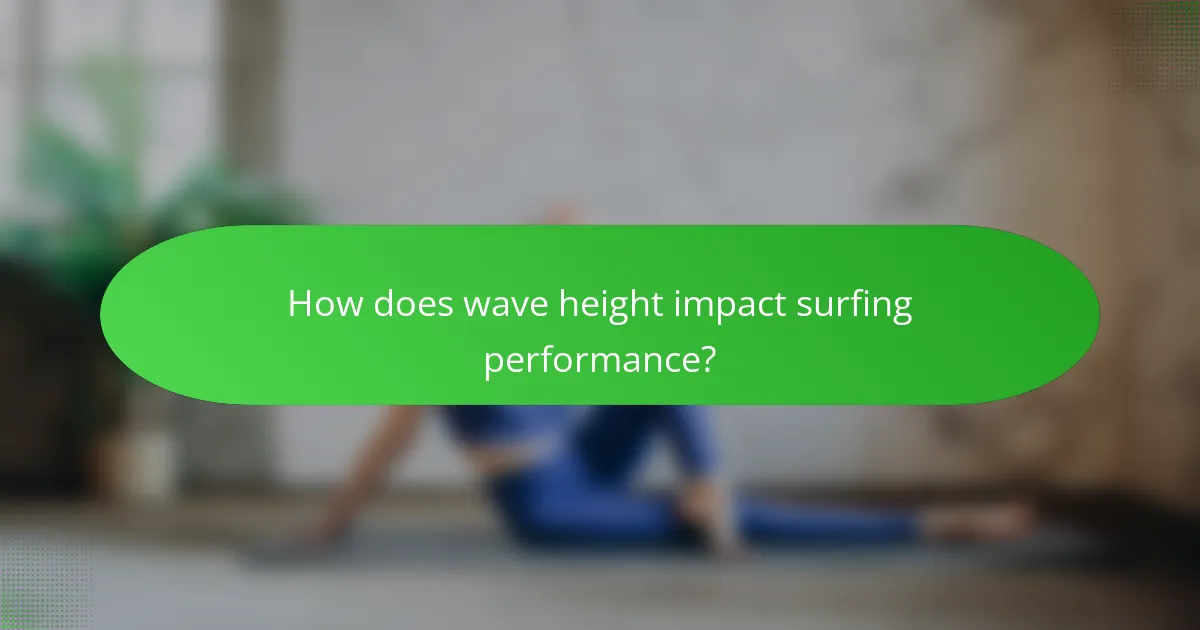Maximising surfing performance hinges on understanding wave height, board type, and rider skill level. Wave height affects speed and manoeuvrability, while board selection influences stability and agility. Rider skill level determines technique and equipment choice, impacting overall performance. This article explores how these factors interact to enhance the surfing experience.

How does wave height impact surfing performance?
Wave height significantly influences surfing performance. Higher waves can enhance speed and manoeuvrability, while smaller waves require different techniques.
Surfers adapt their skills based on wave height. For instance, experienced surfers excel in larger waves, utilising their skills to perform advanced manoeuvres. In contrast, beginners often find smaller waves more manageable, focusing on balance and paddling techniques.
Board type also plays a crucial role. Shortboards are preferred for high waves due to their agility, while longboards offer stability in smaller conditions.
Overall, wave height shapes the surfing experience, affecting both performance and skill application.
What are the optimal wave heights for different skill levels?
Optimal wave heights vary by skill level. Beginners thrive in 1-3 feet waves, while intermediate surfers excel in 3-6 feet. Advanced surfers handle 6-10 feet waves, and professionals can tackle waves exceeding 10 feet. This progression ensures safety and skill development.
How do wave conditions affect ride quality?
Wave conditions significantly impact ride quality by influencing stability, speed, and manoeuvrability. Higher waves can enhance performance for skilled surfers, while inexperienced riders may struggle. Wave shape and consistency also determine how well a board performs. For example, powerful, steep waves may favour shorter boards, while longer boards excel in smaller, rolling waves.

Which board types are best suited for varying wave heights?
Shortboards are best for small waves, while longboards excel in larger swells. The choice of board type significantly affects performance based on wave height.
For waves under 3 feet, shortboards allow for quick manoeuvres and agility. For waves between 3 to 6 feet, funboards offer a balance of stability and performance. Longboards shine in waves over 6 feet, providing better paddling power and wave-catching ability.
Rider skill level also influences board selection. Beginners may prefer longboards for their stability, whereas advanced surfers can utilise shortboards for technical tricks.
Ultimately, selecting the right board type enhances the surfing experience by matching the equipment to wave conditions and rider capabilities.
What characteristics differentiate shortboards and longboards?
Shortboards are designed for agility and speed in smaller waves, while longboards provide stability and ease in larger waves. Shortboards typically measure 5 to 7 feet, allowing quick turns and manoeuvres. Longboards range from 8 to 12 feet, making them ideal for cruising and noseriding. Rider skill level also plays a role; shortboards require advanced techniques, whereas longboards suit beginners.
How does board material influence performance in different conditions?
Board material significantly affects surfing performance by influencing speed, manoeuvrability, and stability across various wave conditions. For instance, a lightweight foam core enhances agility in smaller waves, while a heavier epoxy construction provides better performance in larger swells. Different materials also respond uniquely to water dynamics, impacting how a board holds its line and performs under pressure. Ultimately, selecting the right board material tailored to specific conditions can enhance a surfer’s overall experience and effectiveness.

What role does rider skill level play in surfing performance?
Rider skill level significantly impacts surfing performance. Advanced surfers can navigate larger waves and execute complex manoeuvres, while beginners may struggle with balance and control. Skill level influences wave selection, paddle efficiency, and overall confidence in the water. As riders improve, they can adapt their techniques to different board types and wave conditions, enhancing their performance.
How can beginners improve their skills in relation to wave height?
Beginners can improve their skills in relation to wave height by practising in smaller waves and gradually progressing. Focus on understanding wave dynamics, timing, and positioning to enhance performance. Utilising a suitable board type for wave conditions also aids in skill development. Engaging in regular practice and seeking feedback from experienced surfers can significantly boost confidence and technique.
What advanced techniques can experienced surfers use to maximise performance?
Experienced surfers can maximise performance by employing advanced techniques like optimising wave selection, refining paddle efficiency, and adjusting body positioning. These methods enhance control and speed.
Focusing on wave height, surfers should prioritise larger waves for more powerful rides, while selecting the right board type—shortboards for agility or longboards for stability—can significantly impact manoeuvrability.
Moreover, improving rider skill level through consistent practice and feedback allows for better execution of complex manoeuvres. Techniques like carving, aerials, and tube riding require precise timing and balance, which can be achieved with dedicated training.
Lastly, utilising technology such as surf apps for real-time data on wave conditions helps surfers make informed decisions, ultimately enhancing their performance on the water.

Why is understanding local wave patterns essential for surfers?
Understanding local wave patterns is crucial for surfers as it directly impacts their performance and safety. Knowledge of wave height, direction, and frequency helps surfers choose the right board type and adapt their techniques accordingly. For example, larger waves require different skills and equipment than smaller ones. Additionally, recognising local conditions can enhance a surfer’s ability to catch waves effectively, improving their overall experience.
How do seasonal changes affect wave height and quality?
Seasonal changes significantly impact wave height and quality, influencing surfing conditions. For instance, winter months often produce larger swells due to stronger storms, resulting in higher wave heights. In contrast, summer typically brings smaller, more consistent waves, ideal for beginners. Seasonal wind patterns also affect wave shape and texture, impacting ride quality. As a result, surfers must adapt their board type and technique based on seasonal variations to optimise performance.
Which regions are known for their unique surfing conditions?
Regions known for unique surfing conditions include Hawaii, California, Australia, and Portugal. Each offers distinct wave characteristics influenced by local geography and climate.
Hawaii features powerful waves with heights reaching over 30 feet at spots like Waimea Bay. California has diverse breaks, from Malibu’s mellow swells to Mavericks’ massive waves, catering to different skill levels. Australia boasts consistent surf year-round, particularly at the Gold Coast, known for its long, hollow waves. Portugal’s Ericeira offers world-class reef breaks and is a prime location for advanced surfers.

What are the common mistakes surfers make with board selection?
Common mistakes surfers make with board selection include choosing the wrong board type for their skill level, ignoring wave conditions, and not considering board dimensions. Beginners often select short boards, which can hinder stability. Advanced surfers may underestimate the importance of volume, leading to poor performance in specific waves. Additionally, many surfers fail to account for their weight when selecting a board, affecting buoyancy and control.
How can the wrong board type hinder performance?
The wrong board type can significantly hinder surfing performance by affecting stability, manoeuvrability, and speed. A board that does not match the wave conditions or rider skill level can lead to missed opportunities for optimal performance. For instance, a wider board may provide stability in small waves but can hinder turning ability in larger surf. Conversely, a narrow board may excel in speed but can be challenging for beginners to control. Ensuring the right board type enhances the overall surfing experience and maximises potential.
What should surfers consider when choosing a board for specific conditions?
Surfers should consider wave height, board type, and their skill level when choosing a board. Wave height influences board size; larger waves require shorter boards for manoeuvrability. Different board types, like shortboards or longboards, suit varying conditions and styles. A rider’s skill level also affects board selection; beginners may benefit from wider, more stable boards, while advanced surfers can choose performance-oriented options.

How can surfers optimise their performance through training?
Surfers can optimise their performance through targeted training focused on wave height, board type, and skill level. Training should include strength and conditioning to improve paddling power and endurance.
Practising in various wave heights enhances adaptability. For instance, smaller waves develop technique, while larger waves build confidence and handling skills.
Choosing the right board type is crucial. A shorter board increases manoeuvrability, while a longer board offers stability. Training with different boards can refine skills and help surfers understand their preferences.
Finally, skill level dictates training intensity. Beginners should focus on basics, while advanced surfers can incorporate advanced techniques and competitive strategies. Tailoring training to these factors leads to improved surfing performance.
What exercises enhance balance and agility for surfing?
Exercises that enhance balance and agility for surfing include balance boards, yoga, plyometric drills, and agility ladder workouts. These activities improve core strength and coordination, essential for navigating waves effectively.
Balance boards mimic the instability of a surfboard, enhancing stability and core engagement. Yoga promotes flexibility and body awareness, vital for maintaining posture on the board. Plyometric drills develop explosive power, aiding quick movements and transitions. Agility ladder workouts improve foot speed and coordination, crucial for dynamic surfing manoeuvres.
Incorporating these exercises into a training regimen can significantly boost surfing performance across varying wave heights and board types.
How does mental preparation influence performance on the waves?
Mental preparation significantly enhances surfing performance by boosting focus and confidence. Athletes who mentally prepare often experience improved decision-making and adaptability on the waves. Techniques such as visualization and mindfulness can increase a rider’s ability to assess wave height and respond effectively to conditions. As a result, skilled surfers can better utilise their board type and technique, leading to optimised performance.
What are the best practices for maintaining surfboards for optimal performance?
To maintain surfboards for optimal performance, regularly clean, store properly, and check for damage. Use fresh water to rinse off salt and sand after each session to prevent corrosion. Store boards in a cool, dry place away from direct sunlight to avoid warping. Inspect fins and leash regularly for wear.
